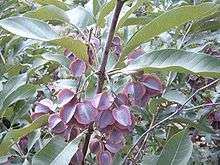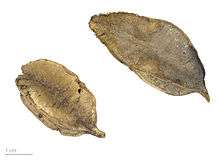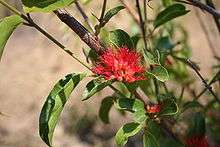Combretum
- "Schousboea" redirects here. As described by H.C.F. Schumacher and Peter Thonning, this is a synonym of Alchornea.
| Combretum | |
|---|---|
 | |
| Combretum collinum with fruit | |
| Scientific classification | |
| Kingdom: | Plantae |
| (unranked): | Angiosperms |
| (unranked): | Eudicots |
| (unranked): | Rosids |
| Order: | Myrtales |
| Family: | Combretaceae |
| Genus: | Combretum Loefl. |
| Species | |
|
About 370, see text | |
| Synonyms | |
|
Aetia Adans. | |
Combretum, the bushwillows or combretums, make up the type genus of the family Combretaceae. The genus comprises about 370 species of trees and shrubs, roughly 300 of which are native to tropical and southern Africa, about 5 to Madagascar, some 25 to tropical Asia and approximately 40 to tropical America. The genus is absent from Australia. Though somewhat reminiscent of willows (Salix) in their habitus, they are not particularly close relatives of these.
Ecology
_in_Kinnarsani_WS%2C_AP_W2_IMG_5783.jpg)
Bushwillow trees often are important plants in their habitat. Savannahs in Africa, in particular those growing on granitic soils, are often dominated by Combretum and its close relative Terminalia. For example, C. apiculatum is a notable tree in the Angolan mopane woodlands ecoregion in the Kunene River basin in southern Africa.[1]
Other species of this genus are a major component of Southwestern Amazonian moist forests. This genus contains several species that are pollinated by mammals other than bats, which is quite rare indeed.[2] But most species are more conventionally pollinated by insects or birds.
Typhlodromus combretum, a mite of the family Phytoseiidae, was discovered on a bushwillow plant and is named after this genus. Other herbivores that eat Combretum foliage include the caterpillars of the Brown Awl (Badamia exclamationis) which is found on C. albidum, C. latifolium and C. ovalifolium; those of the Orange-tailed Awl (Bibasis sena) are recorded from C. extensum and C. latifolium.
Use by humans


Several species are used in African or Indian herbal medicine. The class of chemical compounds known as combretastatins were first isolated from South African Bushwillow (Combretum caffrum), from which they get their name. One synthetic derivative, fosbretabulin disodium (combretastatin A4 phosphate), underwent preliminary study for the treatment of anaplastic thyroid cancer,[3] but it was not effective enough to progress to more advanced trials. C. molle is also recorded to contain antioxidants such as punicalagin, which is also found in pomegranates (Punica granatum), a somewhat related plant.
The botanist George Don studied this genus extensively. The Luvuvhu River in southern Africa was named after the River Bushwillow (C. erythrophyllum), locally known as muvuvhu.
Selected species
|
|
References
- ↑ C.Michael Hogan. 2012. Kunene River. Topic ed. P.Saundry. Encyclopedia of Earth. National Council for Science and the Environment. Washington DC.
- ↑ Carthew, S (1997). "Non-flying mammals as pollinators". Trends in Ecology & Evolution. 12 (3): 104–108. doi:10.1016/S0169-5347(96)10067-7. ISSN 0169-5347.
- ↑ "Combretastatin A4 However there is the possibility that a modified version of an isomer of aombretastatin-A4 can be rendered effective. After replacing adjacent carbon atoms with nitrogen atoms, using blue light, the isomer can be switched to a form that attacks microtubules of cancer cells. So far this has been tested in vitro with breast cancer cells. Phosphate in Treating Patients With Advanced Anaplastic Thyroid Cancer". clinicaltrials.gov.
External links
- Dressler, S.; Schmidt, M. & Zizka, G. (2014). [http://www.africanplants.senckenberg.de/root/index.php?submitForm=true&page_id=77&searchTextMenue=Combretum&filterRegionIDs[]=6&filterRegionIDs[]=1&filterRegionIDs[]=2&filterRegionIDs[]=3&filterRegionIDs[]=5 "Combretum"]. African plants – a Photo Guide. Frankfurt/Main: Forschungsinstitut Senckenberg.
| Wikimedia Commons has media related to Combretum. |
